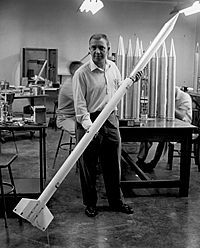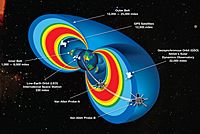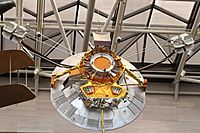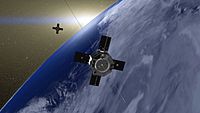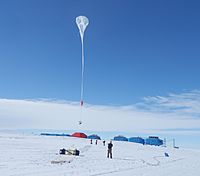James Van Allen facts for kids
Quick facts for kids
James Van Allen
|
|
|---|---|
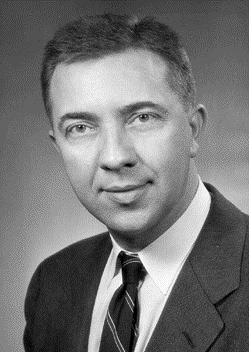 |
|
| Born |
James Alfred Van Allen
September 7, 1914 |
| Died | August 9, 2006 (aged 91) Iowa City, Iowa, US
|
| Education |
|
| Known for | |
| Awards |
|
| Scientific career | |
| Fields | Space science |
| Institutions |
|
| Doctoral advisor | Alexander Ellett https://academictree.org/physics/tree.php?pid=31481 |
| Doctoral students | Michelle Thomsen |
| Other notable students | Nicholas M. Smith Robert Ellis |
| Influenced | James Hansen |
James Alfred Van Allen (born September 7, 1914 – died August 9, 2006) was a famous American space scientist. He worked at the University of Iowa. He helped create the study of Earth's magnetosphere, which is the magnetic bubble around our planet.
The Van Allen radiation belts are named after him. He discovered these belts using special tools called Geiger–Müller tubes. These tools were on early satellites like Explorer 1, Explorer 3, and Pioneer 3 in 1958. This happened during the International Geophysical Year, a time when scientists around the world worked together. Van Allen was a leader in putting scientific tools on space satellites.
Contents
Early Life and Learning
James Van Allen was born on September 7, 1914. He grew up on a small farm near Mount Pleasant, Iowa. As a child, he loved machines and electrical devices. He enjoyed reading Popular Mechanics and Popular Science magazines. Once, he built a Tesla coil that made long sparks. It even made his hair stand on end, which surprised his mother!
Later, a special scholarship allowed him to study nuclear physics. This was at the Carnegie Institution in Washington, D.C. There, he also learned a lot about geomagnetism (Earth's magnetic field), cosmic rays, and the aurora (like the Northern Lights). He also studied the physics of Earth's upper atmosphere.
Working During World War II
In 1939, Van Allen joined the Carnegie Institution. He worked on national defense projects in 1940. He helped develop special detonators called proximity fuzes. These fuses made anti-aircraft guns much more effective. Another project he worked on later became the Manhattan Project, which developed the atomic bomb.
When World War II started, his work moved to the Applied Physics Laboratory (APL) at Johns Hopkins University. He improved parts of these fuses to make them stronger. This work led to new radio-proximity fuses for defending ships and for shore attacks.
In 1942, Van Allen joined the U.S. Navy as a lieutenant. For 16 months, he served on destroyers in the South Pacific. He taught gunnery officers and tested his artillery fuses. He was on the battleship USS Washington when it fought off a Japanese kamikaze attack. This happened during the Battle of the Philippine Sea in 1944. For his actions, he received four battle stars. He was promoted to lieutenant commander in 1946. He later said his time in the Navy was the most important experience of his life.
Exploring the Upper Atmosphere (1946–1954)
After the Navy in 1946, Van Allen returned to research at APL. He led a team at Johns Hopkins University. They used V-2 rockets, which were captured from the Germans, for high-altitude experiments. Van Allen realized they needed smaller rockets for studying the upper atmosphere. He helped design the Aerobee sounding rocket. The first Aerobee with instruments launched on March 5, 1948. It carried tools for cosmic radiation research and reached an altitude of 117.5 kilometers (about 73 miles).
Van Allen also led a group called the Upper Atmosphere Rocket Research Panel. This group helped guide early rocket science.
In 1949, Van Allen and others came up with the idea for the Rockoon. This was a new way to launch rockets.
In 1951, Van Allen became the head of the physics department at the University of Iowa. He quickly got students involved in his research. He found new ways to send instruments higher into the atmosphere. By 1952, he created a system where a balloon lifted a rocket high above Earth's atmosphere. The rocket would then fire even higher. The rockets were launched after the balloons reached an altitude of 16 kilometers (about 10 miles).
Time magazine later wrote about Van Allen's Rockoons. They couldn't be fired in Iowa because the rockets might hit someone's house. So, Van Allen convinced the U.S. Coast Guard to let him launch them from a ship going to Greenland. The first two rockets didn't fire. Van Allen thought the cold might be the problem. So, he heated cans of orange juice and put them with the rocket's clockwork. He then wrapped everything in insulation. The third rocket fired!
In 1953, Rockoons launched near Newfoundland found the first hints of radiation belts around Earth. This low-cost Rockoon method was used by the Office of Naval Research and the University of Iowa in later years.
In 1954, Wernher von Braun, a rocket scientist, wanted a "real scientist" for his satellite project. He sent Ernst Stuhlinger to talk to Van Allen. Van Allen was interested in using a satellite to study cosmic rays around the world.
The International Geophysical Year (1957–1958)
In 1950, a small meeting at Van Allen's home in Washington, D.C., led to a big idea. Scientists talked about past "International Polar Years." They decided it was time for a new worldwide study of Earth. This led to the International Geophysical Year (IGY) planned for 1957–58. This period was chosen because the Sun would be very active then.
The IGY encouraged the U.S. government to launch Earth satellites for science. The Soviet Union then quickly launched its Sputniks. Many say the Space Race began in Van Allen's living room that evening in 1950.
In 1955, the U.S. announced Project Vanguard. This project aimed to launch an artificial satellite as part of the IGY. It was run by the U.S. Navy.
In 1956, Van Allen led a meeting about using satellites for science. He showed how satellites could continue cosmic-ray studies. His team at Iowa got ready to put their scientific tools on Rockoons and Vanguard for the IGY. Because they were ready, their tools were used on the 1958 Explorer and Pioneer launches.
- July 1, 1957: The International Geophysical Year began.
- September 26, 1957: Van Allen's team launched 36 Rockoons from a Navy ship. They launched them in the Atlantic, Pacific, and Antarctic areas. These were the first rocket soundings in the Antarctic.
- October 4, 1957: The Soviet Union successfully launched Sputnik 1. This was the world's first artificial satellite.
- January 31, 1958: The first American satellite, Explorer 1, launched from Cape Canaveral, Florida. It carried a micrometeorite detector and a cosmic ray experiment. Van Allen and his students designed this experiment. Data from Explorer 1 and Explorer 3 (launched March 26, 1958) helped the Iowa group make a huge discovery. They found "a doughnut-shaped region of charged particle radiation trapped by the Earth’s magnetic field."
- July 29, 1958: The U.S. Congress created National Aeronautics and Space Administration (NASA).
- December 6, 1958: Pioneer 3 was launched. It aimed to go near the Moon but did not make it. However, it reached an altitude of 101,000 kilometers (63,000 miles). This gave Van Allen more data. This data led to the discovery of a second radiation belt. These trapped radiation belts start a few hundred miles from Earth and go out for thousands of miles. They are now called the Van Allen radiation belts, named after their discoverer.
A Pioneer in Space Science
The May 4, 1959, issue of Time magazine called James Van Allen the person most responsible for giving the U.S. "a big lead in scientific achievement." They said he was "a key figure in the cold war’s competition for prestige." They noted that the "world-encompassing belts of fierce radiation" now carry his name. No human name had ever been given to such a grand feature of Earth.
James Van Allen, his team, and his students at the University of Iowa kept sending scientific tools into space. They used sounding rockets, Earth satellites (like Explorer 52 / Hawkeye 1), and spacecraft that went to other planets. These included the first missions to Venus, Mars, Jupiter, Saturn, Uranus, and Neptune (Pioneer program, Mariner program, Voyager program, Galileo spacecraft). Their discoveries greatly increased our knowledge of energetic particles, plasmas, and radio waves throughout our solar system.
Van Allen was the main scientist for experiments on 24 Earth satellites and planetary missions.
Later Years and Legacy
Van Allen retired as the head of the Physics & Astronomy Department in 1985. But he continued working at the University of Iowa as a professor. In 2004, the university celebrated his 90th birthday and his many achievements. In 2005, an elementary school named after him opened in North Liberty, Iowa. There is also a Van Allen elementary school in Escalon, California.
In 2009, Van Allen's childhood home in Mount Pleasant was saved from being torn down. It was given to a local trust. They plan to move the house next to an old school, which will become the Henry County museum.
James Van Allen's wife for 61 years was Abigail Fithian Halsey II. They met during World War II. They had five children: Cynthia, Margot, Sarah, Thomas, and Peter.
James Van Allen passed away on August 9, 2006, in Iowa City from heart failure. He and his wife are buried in Southampton, New York.
Honors and Awards
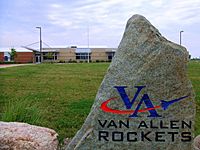
- Elected to the United States National Academy of Sciences (1959)
- Time magazine Man of the Year (1960)
- Elliott Cresson Medal (1961)
- Elected to the American Philosophical Society (1961)
- Iowa Award (1961)
- Elected to the American Academy of Arts and Sciences (1964)
- Distinguished Fellow, Iowa Academy of Science (1975)
- Gold Medal of the Royal Astronomical Society (1978)
- National Medal of Science (1987)
- Golden Plate Award of the American Academy of Achievement (1988)
- Crafoord Prize (1989)
- Vannevar Bush Award (1991)
- NASA's Lifetime Achievement Award (1994)
- National Air and Space Museum Trophy (2006)
- Van Allen Probes (NASA mission, renamed in 2012)
The Van Allen Probes Mission
On November 9, 2012, NASA renamed a mission to study Earth's radiation belts. It was called the Radiation Belt Storm Probes. NASA renamed it the Van Allen Probes mission to honor James A. Van Allen. He was a U.S. space pioneer and a respected professor at the University of Iowa.
The Applied Physics Laboratory, where Dr. Van Allen worked, manages this mission. The main mission was planned for 2 years, but the probes were expected to last for 4 years.
NASA's BARREL Mission
Eighty years after the Second Byrd Expedition, another NASA mission began. It is called the Balloon Array for RBSP Relativistic Electron Losses (BARREL). This mission studies Earth's Van Allen radiation belts from Antarctica. BARREL launched 20 balloons from Antarctica in early 2013 and again in late 2013 to early 2014. The scientific data from BARREL helps scientists understand the Van Allen Probes data even better.
See also
 In Spanish: James van Allen para niños
In Spanish: James van Allen para niños
- George H. Ludwig
- Stamatios Krimigis (Tom Krimigis)
- Explorer program
- Sputnik program
- Sputnik crisis
- Pioneer 10
- Pioneer 11
- Pioneer H



